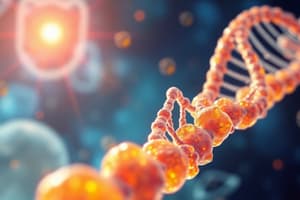Podcast
Questions and Answers
What is the role of helicase in DNA replication?
What is the role of helicase in DNA replication?
- Separates the double helix into two single strands (correct)
- Joins Okazaki fragments
- Adds complementary nucleotides in the 3' to 5' direction
- Adds RNA primers to the DNA strands
Which strand of DNA is synthesized continuously during replication?
Which strand of DNA is synthesized continuously during replication?
- Okazaki strand
- Leading strand (correct)
- Lagging strand
- Discontinuous strand
What describes semiconservative replication?
What describes semiconservative replication?
- Replication occurs simultaneously in prokaryotes and eukaryotes
- DNA is replicated only in the cytoplasm
- All new strands are completely newly synthesized
- Each new double strand contains one original and one newly synthesized strand (correct)
During which process is pre-mRNA converted to mature mRNA?
During which process is pre-mRNA converted to mature mRNA?
Which type of protein is primarily responsible for transporting substances in the body?
Which type of protein is primarily responsible for transporting substances in the body?
Welche Aussage über die Rollen von Primase und DNA-Polymerase ist korrekt?
Welche Aussage über die Rollen von Primase und DNA-Polymerase ist korrekt?
Welche der folgenden Aussagen beschreibt korrekt die Synthese von Okazaki-Fragmenten?
Welche der folgenden Aussagen beschreibt korrekt die Synthese von Okazaki-Fragmenten?
Was bedeutet der Begriff 'semikonservative Replikation' in Bezug auf DNA?
Was bedeutet der Begriff 'semikonservative Replikation' in Bezug auf DNA?
Welche Aussage über die verschiedenen Proteinarten ist nicht korrekt?
Welche Aussage über die verschiedenen Proteinarten ist nicht korrekt?
Was beschreibt am besten die Rolle von DNA-Polymerase während der DNA-Replikation?
Was beschreibt am besten die Rolle von DNA-Polymerase während der DNA-Replikation?
Flashcards are hidden until you start studying
Study Notes
DNA Replication
- DNA replication is the process of creating an identical copy of DNA during interphase, essential for cell division.
- Helicase enzymes break apart the double helix into two single strands.
- Primase adds RNA primers as starting points for DNA polymerase.
- DNA polymerase extends the strands by adding complementary nucleotides in the 5' to 3' direction.
- DNA ligase joins Okazaki fragments in the lagging strand in a 3' to 5' direction.
Replication Mechanisms
- The leading strand is synthesized continuously in the 5' to 3' direction.
- The lagging strand is synthesized discontinuously in short fragments called Okazaki fragments, which are later joined by ligase.
Key Concepts
- Semiconservative replication ensures that each new DNA molecule consists of one original strand and one newly synthesized strand.
- The accuracy and speed of DNA replication vary between prokaryotes and eukaryotes.
From Gene to Protein
- Transcription involves the conversion of DNA into mRNA.
- Pre-mRNA undergoes processing to become mature mRNA.
- Translation is the process where ribosomes use mRNA to synthesize proteins.
Protein Types
- Structural proteins provide form and shape, examples include collagen and keratin.
- Motor proteins enable movement, such as actin and myosin.
- Transport proteins carry substances, including hemoglobin.
- Defensive proteins protect against diseases, for example, antibodies.
- Receptor proteins receive signals, found in cell membranes.
- Signal proteins, like hormones, transmit information, for instance, insulin.
- Storage proteins store substances, such as ferritin.
- Enzymatic proteins catalyze chemical reactions, such as digestive enzymes.
DNA Replication
- DNA replication is the process of creating an identical copy of DNA during interphase, which is essential for cell division.
Replication Process
- DNA replication starts with the unwinding of the DNA double helix, which is performed by helicase.
- Primase creates RNA primers, short sequences of RNA that act as starting points for DNA polymerase.
- DNA polymerase adds complementary nucleotides to the existing strand in a 5' to 3' direction.
- The lagging strand is synthesized discontinuously in short fragments called Okazaki fragments.
- Ligase joins the Okazaki fragments together to create a continuous strand.
Synthesis Mechanisms
- The leading strand is synthesized continuously in the 5' to 3' direction.
- The lagging strand is synthesized discontinuously in Okazaki fragments, which are joined by ligase.
Key Concepts
- Semiconservative replication: Each new DNA molecule consists of one original strand and one newly synthesized strand.
- The rate and accuracy of DNA replication varies between prokaryotes and eukaryotes.
From Gene to Protein
- Transcription: DNA is transcribed into mRNA.
- Processing: Pre-mRNA is processed into mature mRNA.
- Translation: mRNA is translated by ribosomes into proteins.
Protein Types
- Structural Proteins: Provide structural support to cells and tissues, examples include collagen and keratin.
- Motor Proteins: Enable movement within cells and tissues, examples include actin and myosin.
- Transport Proteins: Carry substances throughout the body, examples include hemoglobin.
- Defensive Proteins: Protect the body against diseases, examples include antibodies.
- Receptor Proteins: Receive signals from the environment and transmit them into the cell, examples include receptors in cell membranes.
- Signal Proteins (Hormones): Transmit information between cells and tissues, examples include insulin.
- Storage Proteins: Store substances, examples include ferritin.
- Enzymatic Proteins: Facilitate chemical reactions, examples include digestive enzymes.
Studying That Suits You
Use AI to generate personalized quizzes and flashcards to suit your learning preferences.




